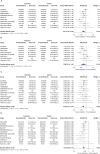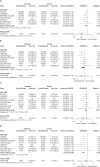The effect of sodium-glucose cotransporter 2 inhibitors in patients with chronic kidney disease with or without type 2 diabetes mellitus on cardiovascular and renal outcomes: A systematic review and meta-analysis
- PMID: 38019892
- PMCID: PMC10686459
- DOI: 10.1371/journal.pone.0295059
The effect of sodium-glucose cotransporter 2 inhibitors in patients with chronic kidney disease with or without type 2 diabetes mellitus on cardiovascular and renal outcomes: A systematic review and meta-analysis
Abstract
Background: Sodium-glucose cotransporter 2 (SGLT-2) inhibitors have shown a favorable effect on cardiovascular and renal outcomes in patients with type 2 diabetes mellitus (T2DM). However, their efficacy in patients with chronic kidney disease (CKD) with or without T2DM has not yet been analyzed.
Objective: To assess the cardiovascular and renal effects of SGLT-2 inhibitors in patients with CKD with and without T2DM, including all CKD patients in the current literature.
Methods: We searched MEDLINE, EMBASE, CENTRAL and Scopus for randomized controlled trials of SGLT-2 inhibitors that evaluated cardiovascular and kidney outcomes in patients with CKD, or trials in which these patients were a subgroup. We defined 2 primary outcomes: a composite of cardiovascular death or hospitalization for heart failure, and a composite renal outcome. For each outcome, we obtained overall hazard ratios with 95% confidence intervals by using a random effects model.
Results: We included 14 randomized controlled trials. SGLT-2 inhibitors decreased the hazard for the primary cardiovascular outcome (HR 0.76; [95% CI 0.72-0.79]) and the primary renal outcome (HR 0.69; [95% CI 0.61-0.79]) in patients with CKD with or without T2DM. We did not find significant differences in the subgroup analyses according to diabetes status, baseline eGFR values or the type of SGLT-2 inhibitor used.
Conclusion: In patients with CKD, treatment with SGLT-2 inhibitors in addition to standard therapy conferred protection against cardiovascular and renal outcomes. Further research on patients with non-diabetic CKD should be done to confirm the utility of these medications in this population. (PROSPERO ID: CRD42021275012).
Copyright: © 2023 Reyes-Farias et al. This is an open access article distributed under the terms of the Creative Commons Attribution License, which permits unrestricted use, distribution, and reproduction in any medium, provided the original author and source are credited.
Conflict of interest statement
The authors have declared that no competing interests exist.
Figures





References
-
- Vos T, Lim SS, Abbafati C, Abbas KM, Abbasi M, Abbasifard M, et al. Global burden of 369 diseases and injuries in 204 countries and territories, 1990–2019: a systematic analysis for the Global Burden of Disease Study 2019. Lancet. 2020;396: 1204–1222. doi: 10.1016/S0140-6736(20)30925-9 - DOI - PMC - PubMed
-
- Willis K, Cheung M, Slifer S. KDIGO 2012 Clinical Practice Guideline for the Evaluation and Management of Chronic Kidney Disease. Kidney International Supplements. 2013;3: 163. Available from: https://kdigo.org/guidelines/ckd-evaluation-and-management/. - PubMed
-
- National Institute for Health and Care Excellence. Chronic kidney disease: assessment and management (NG203). NICE. 2021; 77. Available from: https://www.nice.org.uk/guidance/ng203.
-
- Cosentino F, Grant PJ, Aboyans V, Bailey CJ, Ceriello A, Delgado V, et al. 2019 ESC Guidelines on diabetes, pre-diabetes, and cardiovascular diseases developed in collaboration with the EASD: The Task Force for diabetes, pre-diabetes, and cardiovascular diseases of the European Society of Cardiology (ESC) and the European Association for the Study of Diabetes (EASD). Eur Heart J. 2020;41: 255–323. doi: 10.1093/eurheartj/ehz486 - DOI - PubMed
Publication types
MeSH terms
Substances
LinkOut - more resources
Full Text Sources
Medical
Research Materials
Miscellaneous

